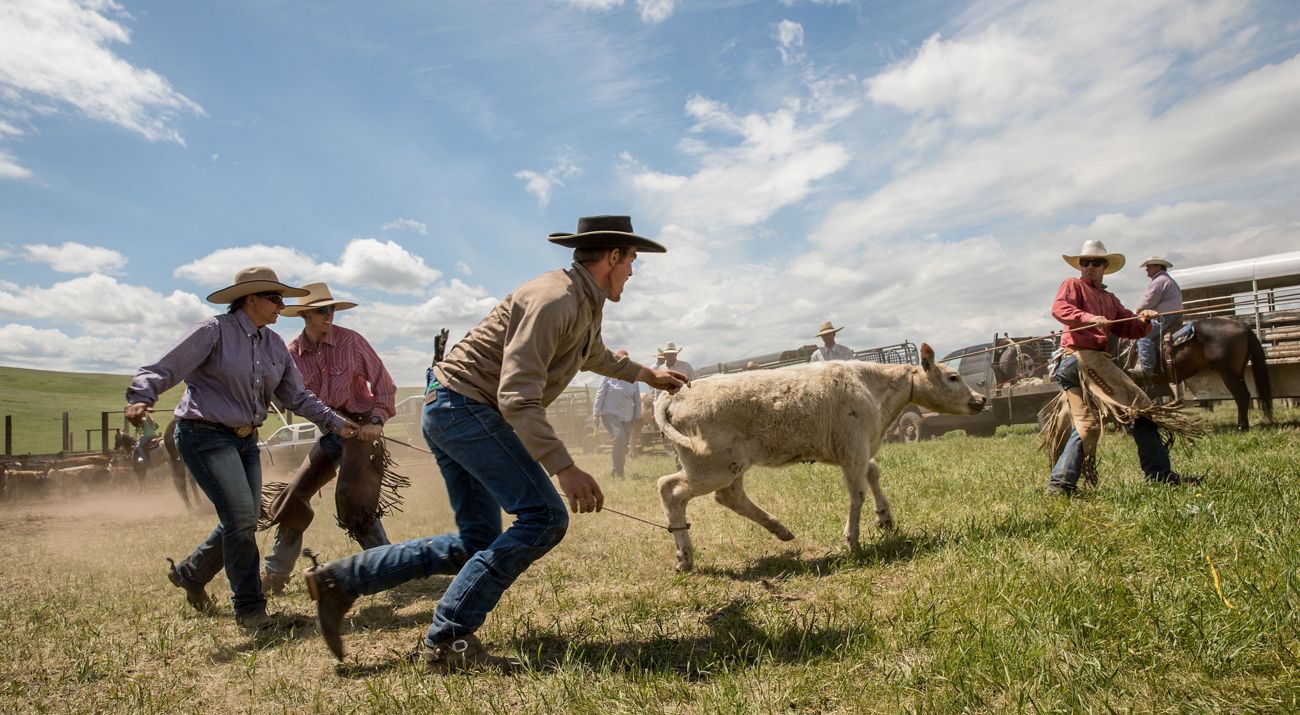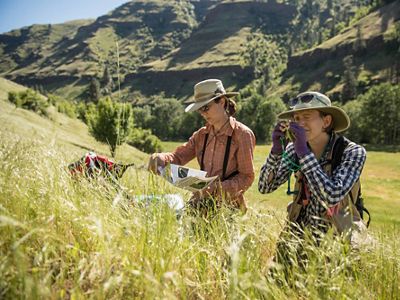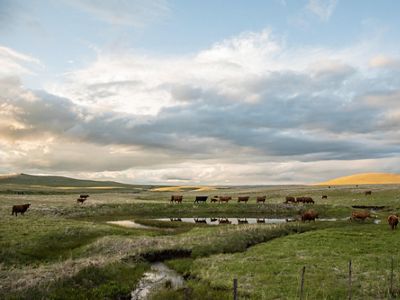
Conservation Cowboys
Scientists and ranchers have forged an uncommon alliance to preserve the rare habitat of Oregon's Zumwalt Prairie.
Winter 2017
On a cool May morning in the high desert of northeast Oregon, Jeff Fields guides his pickup down a dirt road between grass-covered hills. The road emerges into a vista of undulating fields speckled with pink, white, yellow and purple wildflowers. Storm clouds partly obscure a dark line of mountains on the southern horizon.
“The thing about the prairie is, it’s subtle,” says Fields, manager of The Nature Conservancy’s 51-square-mile Zumwalt Prairie Preserve, the largest private preserve in Oregon. “The closer you look, the more you see.”
Fields pulls over at a high point and steps out into a gentle breeze. A prairie falcon swoops above. “It’s not the size of the Great Plains or those other wide-open spaces, but it feels that way,” he says, as a pair of ground squirrels scoot off into the grass and the buoyant notes of a western meadowlark sound nearby.
In fact, TNC’s preserve encompasses only about a tenth of the Zumwalt Prairie, the United States’ largest remaining chunk of Pacific Northwest bunchgrass prairie. The Conservancy began buying land here in 2000, and leases portions of its preserve to Wallowa County ranchers. Indeed, most of the prairie consists of ranches that seasonally graze sheep and cattle.
“At first we were pretty focused within our fence lines,” Fields says about the early days of TNC’s conservation work here. “But we started to realize that we could buy and manage only so much. We started asking ourselves what we needed to do to see conservation happen across this entire grassland.”
Grasslands need some kind of disturbance to thrive over time, says Fields. “Well-managed grazing is probably our best opportunity to conserve and improve this grassland,” he says. “At the same time, if it’s poorly done it can have really dramatic negative impacts.”
And so Fields and his colleagues began thinking about how to work more closely with their ranching neighbors for the good of the prairie. “This is a working landscape,” he says. “It has been for generations. It’s not as simple as saying, 'Just kick the cows off.’ We don’t have that option.”

The entire Zumwalt Prairie covers about 500 square miles of Wallowa County. Nearby, the snow-dusted peaks of the Wallowa Mountains bump up against Hells Canyon, carved by the Snake River on the Idaho border.
Wedged between Hells Canyon and the Wallowa Mountains, Zumwalt Prairie forms an island of gently rolling private grasslands surrounded by public lands. It’s also an ecological rarity: the last, best remnant of a bunchgrass prairie ecosystem distinctive to this region where Oregon, Washington and Idaho meet. While most of it was converted to agriculture elsewhere, here a combination of higher elevations, rougher climate and less-fertile soils made the prairie more suitable for seasonal grazing, which has left it much more intact.
Bunchgrass prairie, like the sod-forming tallgrass prairie of the Great Plains, evolved with regular disturbance by fire and grazing herbivores. While fire has been greatly suppressed, herbivores—today most often in the form of elk, cattle and sheep—can still play an important role in maintaining the diversity of plants and wildlife.
The bunchgrass prairie of Zumwalt is dominated by shorter native grasses like Idaho fescue and bluebunch wheatgrass, which grow in clumps that leave space for bare ground and other plants like wildflowers. Ranging between 3,500 and 5,000 feet in elevation, Zumwalt gets only about 14 inches of precipitation annually.
Equally divided between plateau and river canyons, TNC’s preserve is an important breeding area for grassland songbirds like the horned lark and vesper sparrow, as well as for more than a dozen raptor species. Elk and deer abound, and even gray wolves have returned to the region.
To understand how sheep and cattle can be managed to maintain and improve the health of the prairie, or at least to harm it as little as possible, TNC set aside 1,600 of its 33,000 acres in 2005 for experiments with sustainable grazing. It launched research projects with Oregon State University and the University of Idaho to look at things like how grazing affects species diversity in the ecosystem and how it interacts with other management practices like prescribed fire.
Conservancy staffers have been putting the data to practical use in running the preserve’s grazing lease program, conducted by rangeland specialist Mike Hale. Every year, half a dozen or so local ranchers pay TNC to run animals on the preserve under a carefully managed rotational system. About half of the preserve is open to grazing, with pastures alternating between short, intense periods of use and long periods of rest. The lease program let TNC begin a conversation with nearby ranchers, Hale says, and helped win them over slowly, season by season. “I remember when some people just called the Conservancy ‘Nature,’” says Hale. “Like, ‘You work for Nature?’”
When the organization first arrived in Zumwalt, local attitudes could be best described as wary, Fields says. The Conservancy helped allay some fears when it continued existing grazing leases on its new preserve and chose to pay property taxes, even though it isn’t required to as a nonprofit. And unlike other environmental groups that had already come and gone, TNC staffers moved to the county and engaged with the community, helping to rehabilitate historic buildings and raise money for local service organizations’ projects. The group hired more staff locally and opened its land to school groups for science projects. A 2002 editorial in the Wallowa County Chieftain reported, “If they aren’t careful, leaders of The Nature Conservancy are going to give environmental groups a good name in conservative Wallowa County.”
On a late afternoon, three cattle dogs sprint around a pasture on the prairie, trying to keep a hundred or so cows in some semblance of order. Rancher Dan Probert watches the dogs at work, amid a cacophony of barks and moos. It’s the end of a long day of branding and wrangling; a gate had gotten open somehow, two herds mixed, and sorting things out seemed to take forever.
Probert’s property lies just to the south of the Zumwalt Prairie Preserve. This spring he finalized the first long-term conservation easement in Zumwalt, a pioneering agreement that ensures his land remains undeveloped and is managed in an ecologically sound manner. Bringing the agreement to fruition was an enormous undertaking that was four years in the making, involving not only Probert and TNC, but a host of federal and nonprofit partners.
When Probert and his family bought the 12,000-acre Lightning Creek Ranch next to the preserve in 2013, they began talking to TNC about possibly placing a conservation easement on their land. Under the proposed easement, which would stay with the property even if it were sold, the Proberts would give up the right to farm or develop the land for housing, wind power or mineral extraction, in exchange for a payment. The easement would also require the Proberts to follow a comprehensive grazing management plan.
To see if such an arrangement could work, the Proberts took a leap of faith and began developing a grazing plan with TNC. They implemented a first iteration in 2015. Encouraged by the experience, the family finalized a legal easement in 2017, for which TNC, the Climate Trust, the Doris Duke Charitable Foundation and the USDA Natural Resources Conservation Service contributed $2.6 million.
Part of the financing for the Probert purchase came from an investment in the project’s potential to absorb carbon. “This is the first project we know of in the Pacific Northwest where carbon credits have been earned for keeping grasslands intact,” says Derek Johnson, who directs TNC’s protection and stewardship efforts in Oregon. Companies seeking to offset their emissions buy such credits through a voluntary carbon market.
The grazing management plan for Lightning Creek Ranch has been refined each year since 2015 with TNC’s help. “It has been a great collaborative experience,” says Probert. “If we can agree on values we all want to maintain in perpetuity, and I can make a living at it ranching, and TNC doesn’t have to pay for maintenance, it’s a win-win.”
As to whether his neighbors would join similar agreements, Probert is cautiously optimistic. “I think they’re waiting and seeing,” he says. “I don’t think most of them would have a big problem giving up development rights. But to have someone involved in your grazing management—that’s a big step.”
Probert took that step because the plan is built around outcomes—the condition it leaves the prairie in—rather than how the outcome is achieved. “We didn’t spend a lot of time talking about tools,” Probert says. “As long as we monitor for outcomes and are meeting or exceeding them, the numbers of livestock don’t matter, or when we grazed.” Being able to make those decisions himself was important, he says.
The Conservancy hopes to close similar deals on another 20,000 acres within the next two to three years, Johnson says. “Easements are a more cost-effective way to achieve protection, and people are also more comfortable working with us that way. It’s about learning what’s good for both the producer’s bottom line and the ecological system.”

The Zumwalt project's combination of scientific research and practical application fits into a larger TNC push to create a network of working grassland sites that share information and improve rangeland health across big stretches of grass, from northern Montana all the way to Argentine Patagonia, says William Burnidge, director of TNC’s Sustainable Grazing Lands program in Colorado. “The Zumwalt project is a tremendous learning site for conservation,” he says. “We can take what we learn from other places and apply it here, and also carry those lessons to the outer world.”
One Zumwalt innovation that might expand beyond Oregon is a land management tool being developed by Vincent Jansen, a doctoral student at the University of Idaho and former TNC staffer. A major challenge in grassland ecology is how difficult it can be to measure something as basic as biomass, or how much grass is on the ground, he says. Jansen’s project uses years of images from Landsat satellites, which he fine-tunes with data gathered from hundreds of sites across Zumwalt.
“The ultimate goal is to help landowners understand what’s happening on their properties at a large scale,” Jansen says. His web-based tool allows landowners—six are involved so far—to monitor the health of their properties, including how vegetation cover changes from year to year. The information helps them make better decisions—starting with where to put their cows, when and for how long.
“The ranchers are very receptive to learning and sharing and participating,” he says. “They’re already integrating all these things we’re thinking of, just in their minds. Their mental models are very sophisticated.” By integrating satellite data with this knowledge based on decades of experience, Jansen hopes to make collaboration easier and more effective. And the learning process works both ways: Jansen is getting the landowners’ input on how to make the tool better fit their needs. For example, he plans to add climate and precipitation data to future iterations of the tool, based on rancher feedback.
Clint Krebs is one of the ranchers testing out Jansen’s creation. A sheep and cattle rancher, Krebs is considering an easement on his property adjacent to the Zumwalt Prairie Preserve. He says he prefers the term “steward” instead of property owner. “I don’t believe you can really own land. I want to improve this land and leave it in better ecological shape than when I took it over.”
Such shared values give TNC’s Johnson great hope. “We have the right ingredients to really do something together at Zumwalt,” he says, pointing to the relative health of the prairie, the engaged ranching community and the many research partnerships at work. “In 10 years, we don’t want to just be describing Zumwalt as the last, best grassland of its kind.” Rather, he hopes, Zumwalt will be the place where people figured out how best to use a grassland sustainably.